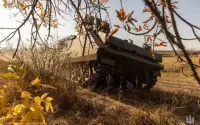'Thousand cuts': what's behind Russia's renewed push on Dnipro front
global.espreso.tv
Wed, 29 Oct 2025 20:16:00 +0200

The invading Russian forces are trying to pressure the Dnipropetrovsk region from several directions at once, using a "thousand cuts" tactic. The offensive is ongoing at the junction of the Dnipropetrovsk and Zaporizhzhia regions, and in the Pokrovsk and Velykomykhailivka directions. Russia's main goal is to expand military operations into territories not included in the Russian constitution by Putin's decree."Recently, information appeared in Russian and Ukrainian media about the capture of several settlements in the Dnipropetrovsk region, which was later refuted by the Ukrainian Armed Forces' General Staff."Specifically, there were reports of the alleged capture of the settlement of Kalynivske in the Dnipropetrovsk region by Russia.As a reminder, on October 2, the DeepState project reported that Russian troops had captured two settlements in the Dnipropetrovsk region. Subsequently, the 20th Army Corps reported that the Defense Forces of Ukraine control the situation in the village of Kalynivske and that the Russian advance has been stopped.And on October 3, the Defense Forces of Ukraine conducted a successful clearing operation against Russian troops in Sosnivka, Khoroshe, Novoselivka, and Snizhne in the Dnipropetrovsk region. Despite a series of successful counterattacks by the Ukrainian Armed Forces in this direction, the Russian enemy (troops of the 5th, 29th, 36th, and parts of the 35th Combined Arms Army, as well as a number of reinforcement units and formations) continues to advance in most of its sectors.On October 13, the occupation of the village of Ternove in the Dnipropetrovsk region was reported.Over the past 24 hours, the Russian army carried out 14 attacks in the areas of the settlements of Fyliia, Sosnivka, Novoyehorivka, Orestopil, Pavlivka, Kalynivske, and in the direction of Pryvillia.According to military expert Vladyslav Selezniov, a reserve colonel of the Ukrainian Armed Forces, the fighting in the Dnipropetrovsk region is part of the Russian troops' tactic of creating so-called sanitary zones along the Ukrainian-Russian border. The intensification of hostilities in the region is linked to Russia's desire to advance deeper into Ukrainian territory and influence the overall course of the war.Currently, the Russian forces are trying to expand their zone of presence in the Dnipropetrovsk region, but the Ukrainian Armed Forces' General Staff has a clear understanding of this situation.This involves the redeployment of operational reserves and minimizing possible breakthroughs by the Russian invaders. That is, at this time, we can say that the Russian General Staff's plans to create a wide so-called buffer zone in the Dnipropetrovsk region have failed, just as they did in the Kharkiv and Sumy regions. And this once again demonstrates that the Defense Forces are successfully using active defense tactics."The Ukrainian Armed Forces are not only exhausting the enemy by inflicting significant blows on manpower and equipment but are also successfully counterattacking when necessary. And the Russians' tactics have not changed."First and foremost is terror against the civilian population. And the Dnipropetrovsk region, unfortunately, is no exception. Strikes with FABs (high-explosive aviation bombs) and Solntsepek thermobaric systems on populated areas essentially leave them in a state of scorched earth. It is worth noting that Dnipro has already been the target of high-precision weapon strikes. In particular, on October 9, Russia used the Grom-E1 cruise bomb-missile against the city for the first time. The next day, October 10, the Russians tried to repeat the attack, but two carriers of KABs (guided aerial bombs) were successfully shot down by Ukrainian Air Defense Forces in the suburbs.As noted by military expert Oleh Zhdanov, the Russian army is unable to strike Dnipro with conventional guided aerial bombs (KABs) due to their insufficient range. At the same time, the enemy has a limited number of extended-range weapons, such as the Grom-E1 or other similar high-precision munitions, which also affects the assessment of the overall strategic danger to the region.It is noteworthy that the activation of invading forces in the Dnipropetrovsk region is primarily of an informational and political nature. Understanding the impossibility of a military scenario to capture the territory of the Donetsk region, they are resorting to outright blackmail. They are using the opportunity to expand the theater of military operations by capturing individual territories of the Sumy, Dnipropetrovsk, and Kharkiv regions.Specially for EspresoAbout the author. Dmytro Sniehyrov, military expert, co-head of the civic initiative Prava Sprava.The editorial board does not always share the opinions expressed by the authors of the blogs.








